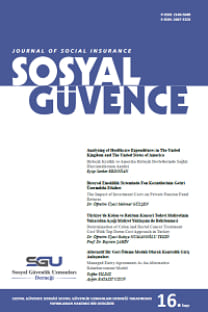MALİYET ETKİNLİK VE AHLAKİ PERSPEKTİF KARMASI İLE KANSER TEDAVİSİNDE TERCİH GELİŞTİRME: ABD ÖRNEĞİ
Dünyada sağlık harcamaları yükselme eğilimdedir ve ekonomik pastadan her geçen gün daha büyük pay almaktadır. Kaynakların dağıtımı, kısıtlı kaynaklar altında önem kazanmaktadır. Kanser, ölümün önde gelen sebeplerinden biridir ve her geçen yıl kanser tedavisine harcanan para artış göstermektedir. Bugün, kanser tedavisi ve ilaçları, yüksek maliyetine rağmen kısıtlı bir fayda sağlamaktadır. Bu yüzden, sadece kısıtlı sayıda insan tedaviden faydalanmakta ve az sayıda tedavi ve ilaç geri ödeme kapsamındadır. Ayrıca, birçok ülke bir ilaç ya da tedavinin geri ödenip ödenmemesine karar verme konusunda bir standarda sahip değildir. Sağlık faydalarını maksimize etmek ve kaynakları adil dağıtmak için geri ödeme sürecinde hem ekonomik etkililik (maliyet etkinlik analizi) hem de ahlaki etkenler büyük önem arzetmektedir.
Anahtar Kelimeler:
Kanser tedavisi ve ilaçları, geri ödeme süreci, maliyet ethinlik analizi, sağlık etiği, kaynak dağıtımı
IMPROVING DECISION MAKING IN CANCER TREATMENT WITH A MIX OF COST-EFFECTIVENESS ANALYSIS AND ETHICAL PERSPECTIVE: USA EXAMPLE
In the world, healthcare costs have been on the rise and getting larger share in the economic pie. Since we have limited resources, allocation of resources becomes more of an issue. Cancer is one of most leading causes of death in the world and each year, money spent on cancer treatment goes up. However, today new cancer drugs and treatment only provide narrow benefit with very high costs. Therefore, only limited number of people enjoys getting the treatment and fewer treatment or drugs are reimbursed. In addition, many countries do not have a standard to decide whether a cancer drug or a treatment will be covered. Considering both economic efficiency (cost-effectiveness analysis) and ethical issues together during the decision process is of great importance so as to distribute health resources fairly and maximize health benefits
Keywords:
Cancer treatment and drugs, reimbursement process, cost-effectiveness analysis, health ethics, resource allocation,
___
- Centers for Medicare and Medicaid Services. 2013. Office of the Actuary, National Health Statistics Group. National Health Care Expenditures Data. February 2013.
- Schnipper L. Meropol N. and Brock D. 2010. Value and cancer care: Toward an equitable future. Clinical Cancer Research 2010. 16:6004- 08.
- Brock D. 1997. Considerations of equity in relation to prioritization and allocation of health care resources. Ethics, Equity and Health For All. Geneva: WHO and CIOMS.
- Pliskin J. S. Shepard D. S. and Weinstein M. C. 1980. Utility functions for life years and health status. Operations Research 28: 206–24.
- Devlin N. and Parkin D. 2004. Does NICE have a cost-effectiveness threshold and what other factors influence its decisions? A binary choice analysis. Health Economics 13 (5): 437–52.
- Brock D. 2003a. Separate spheres and indirect benefits cost- effectiveness and resource allocation. Cost Effectiveness and Resource Allocation. 1: 4. 114.
- Rawls J. 1971. A Theory of Justice. Cambridge, MA: Harvard University Press.
- Pinkerton S. Johnson-Masotti A. Derse A. amd Layde P. 2002. Ethical issues in cost-effectiveness analysis. Evaluation and Program Planning. Vol. 25. 1: 71-83
- Fox J. 2005. Medicare should, but cannot, consider costs: Legal impediments to a sound policy. Buffalo Law Rev.53:577–633.
- Brock D. 2010. Ethical and value issues in insurance coverage for cancer treatment. The Oncologists. 15(suppl 1):36–42
- Brock D.2003b. Ethical issues in the use of cost effectiveness analysis for the prioritization of health care resources. In Making Choices in Health: WHO Guide to Cost-Effectiveness Analysis, Geneva:World Health Organization.
- Brock D. 2002. Priority to the worst off in health care resource prioritization. In: Battin M. Rhodes R. Silvers A. Medicine and Social Justice. New York: Oxford University Press:362–72.
- Daniels N. 1993. Rationing fairly: Programmatic considerations. Bioethics 7 (2–3): 224–33.
- Gold M. Siegel J. Weinstein M. and Russell L. 1996. Cost- Effectiveness inHealth and Medicine. NewYork: Oxford University Press.
- Daniels N. 1988. Am I my parents’ keeper? An essay on justice between the young and the old. New York: Oxford University Press.
- ISSN: 2146-5649
- Yayın Aralığı: Yılda 2 Sayı
- Başlangıç: 2011
- Yayıncı: Sosyal Güvenlik Uzmanları Derneği
Sayıdaki Diğer Makaleler
MALİYET ETKİNLİK VE AHLAKİ PERSPEKTİF KARMASI İLE KANSER TEDAVİSİNDE TERCİH GELİŞTİRME: ABD ÖRNEĞİ
Kısmi Süreli Çalışmanın İş Ve Sosyal Güvenlik Hukuku Kapsamında Değerlendirilmesi
Fiili Hizmet Süresi Zammı Uygulamasının Türk Sosyal Güvenlik Sistemine Etkisi
